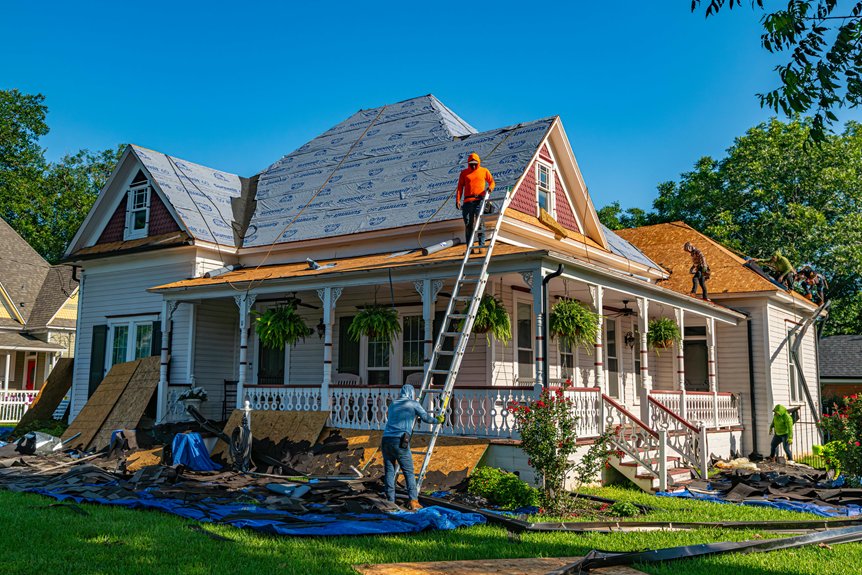Deciding whether to repair or replace your roof can seem overwhelming, especially with so many factors to weigh, ponder, or evaluate. Your roof’s age, condition, and recent damage play a big role in the decision, but understanding these elements isn’t always straightforward. Making the right choice can save you money and protect your home long-term. To navigate this process confidently, it helps to know what signs to look for and how your options stack up.
Assessing the Age and Condition of Your Roof
Understanding the age and condition of your roof is essential in determining whether it needs repair or replacement. If your roof is over 20 years old, it’s more prone to storm damage and overall wear, signaling the need for a closer inspection. Regular inspections can reveal hidden issues caused by storms or aging. If your roof shows extensive wear or your materials are outdated, replacement might be the best option. Knowing your roof’s age and material condition helps you make informed decisions about repairs, ensuring your home stays protected. Conducting a professional roof inspection can help identify issues that are not visible to the untrained eye.
Identifying Signs of Damage and Wear
To determine whether your roof needs repairs, you should regularly look for clear signs of damage and wear. Hail damage often appears as dents, cracks, or missing shingles, which can compromise your roof’s integrity. Check for visible dents or bruises on metal components and shingle granule loss, indicating impact.
Algae growth appears as dark streaks or patches, especially in shaded areas, and can cause shingles to deteriorate faster. Look for curling, cracking, or missing shingles, as well as sagging or water stains on ceilings that suggest leaks.
Regular inspections help catch issues early, preventing costly repairs later. If you notice any of these signs, it’s time to think about professional assessment to determine whether repair or replacement is necessary.
Understanding Cost Factors for Repairs and Replacements
When considering whether to repair or replace your roof, knowing the factors that influence costs can help you make informed decisions. Material options play a significant role; for example, asphalt shingles are more affordable, while metal or slate options tend to cost more but last longer. Your choice impacts overall expenses and durability.
Additionally, contractor selection affects costs—experienced, reputable contractors may charge higher rates but can ensure quality work and proper installation, reducing future repairs. Labor costs vary depending on the project’s complexity and the area’s market rates.
Other factors include the roof’s size, pitch, accessibility, and whether existing damage requires additional repairs. Understanding these cost factors helps you budget wisely and choose the best solution for your home’s needs.
Weighing Long-Term Benefits and Savings
While upfront costs are important, weighing the long-term benefits and savings of roof repair or replacement helps you make smarter financial choices. A new roof can reduce ongoing repair expenses and lower energy bills thanks to improved insulation.
When considering insurance claims, a properly installed roof might result in better coverage and fewer disputes. Additionally, choosing the right contractor ensures quality work that lasts longer, saving you future repair costs.
A durable roof can increase your home’s value over time and prevent costly damage from leaks or storms. While initial expenses may seem high, the long-term savings in repairs, energy efficiency, and insurance benefits make replacement a smart investment.
Evaluating these factors helps you decide whether repair or replacement offers the best financial outcome.
Considering Future Plans and Home Value Impact
Considering your future plans and how your home’s value may be affected can considerably influence your decision between repairing or replacing your roof.
If you’re planning to sell soon, a new roof can boost your home’s aesthetic appeal and attract buyers. Additionally, a roof in good condition may improve your insurance coverage options, potentially lowering premiums or making claims smoother.
On the other hand, if you’re not planning to move, repairing might suffice for now. But keep in mind that neglecting necessary updates could diminish your home’s value over time. Think about how future renovations or upgrades might be impacted by your roof’s condition.
Balancing these factors ensures you make a decision that aligns with your long-term goals and maximizes your home’s worth.
Making the Best Decision for Your Yukon Home
Deciding whether to repair or replace your Yukon home’s roof depends on evaluating your current needs, budget, and long-term plans.
Consider how roof insulation upgrades could improve energy efficiency, especially in the Yukon climate, making repairs more cost-effective. If you’re planning to add solar panels, a full replacement might be better, as new roofs often come prepped for solar integration.
Think about your home’s age, existing damage, and future goals. If your roof is nearing the end of its lifespan or has significant issues, replacement could save money and enhance energy savings over time. Conversely, minor damages might only require repairs.
Ultimately, balancing your immediate needs with future energy and insulation goals will guide you toward the best decision for your home.
Conclusion
Deciding whether to repair or replace your Yukon roof depends on its age, condition, and extent of damage. Regular inspections and honest assessments are essential to making the best choice for your home’s safety, energy efficiency, and value. While repairs can be a cost-effective solution for minor issues, a full replacement may be the smarter long-term investment for older or severely damaged roofs. Trust your instincts and consult with roofing professionals to ensure your home remains protected and in top shape. For more information on how to schedule your free roof inspection, call us at (405) 543-2920 or visit us online at Top View Roofing.











